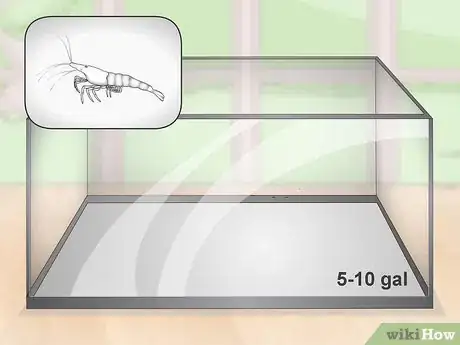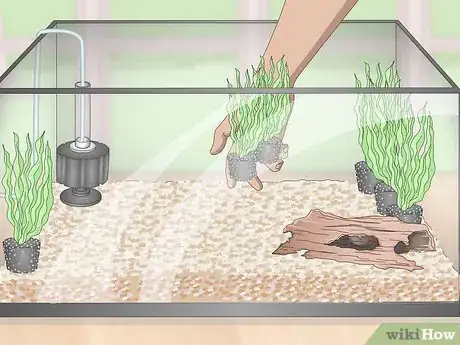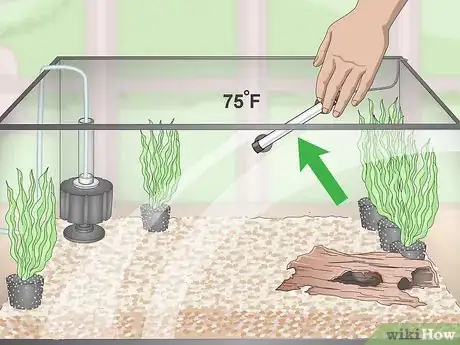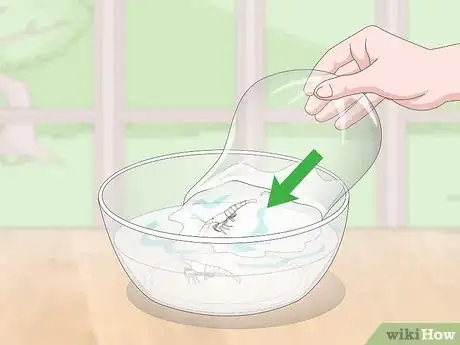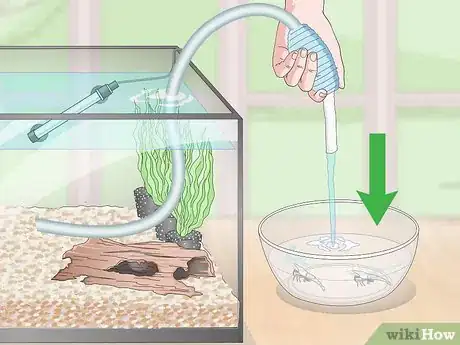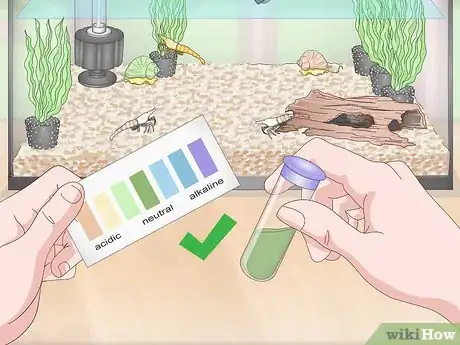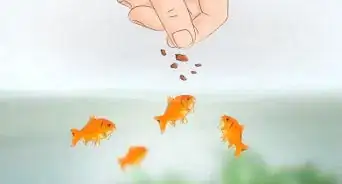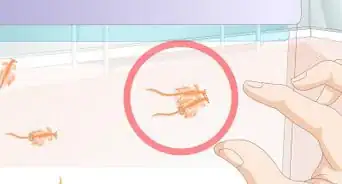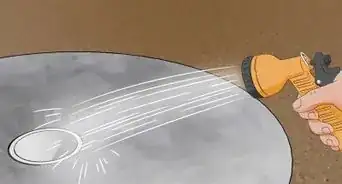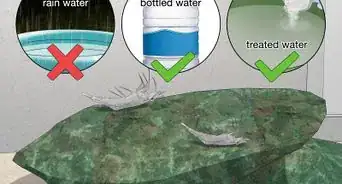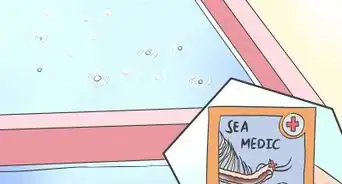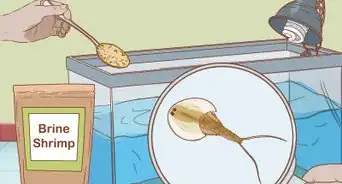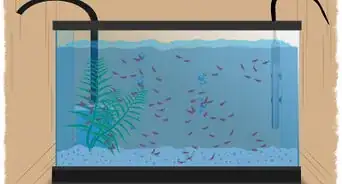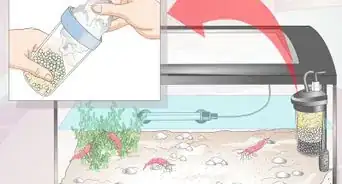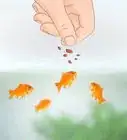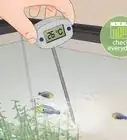This article was co-authored by Marshall Stephens. Marshall Stephens is an Aquarium Expert at Private Oceans Aquariums in West Palm Beach, Florida. Marshall has over 20 years of experience in the aquarium industry and focuses on captive-bred animals. They specialize in tropical and marine aquariums and are a contributor to the Loggerhead Marine life center in Jupiter Florida.
wikiHow marks an article as reader-approved once it receives enough positive feedback. This article received 32 testimonials and 100% of readers who voted found it helpful, earning it our reader-approved status.
This article has been viewed 387,115 times.
Ghost shrimp are interesting, low-maintenance aquatic pets. Also known as glass shrimp, translucency is their most recognizable trait. They’re fairly hardy, and you’ll just need to ensure the water’s temperature, chemical, pH, and oxygen levels are within healthy ranges. While they only live about a year, they tend to breed rapidly, so you establishing a long-term colony is super easy!
Steps
Setting up the Tank
-
1Keep your shrimp in a 5 to 10 gallon (19 to 38 L) aquarium. Choose a tank no smaller than 5 gallons (19 L) for your pets. A larger tank is preferable if you're raising a large number of shrimp. As a rule of thumb, the tank should hold 1 gallon (3.8 L) of water for every 10 ghost shrimp it houses.[1]
- Shop for tanks for aquatic pets online or at a pet store. Go with a tank that has a secure lid. Believe it or not, ghost shrimp can jump out of the water and escape!
- If you have an existing aquarium and want to add shrimp to it, keep in mind shrimp don’t do well with most fish species. Unless you’re raising the shrimp to feed your fish, keep them in a tank with other shrimp, snails, and docile fish, such as Cory catfish.
-
2Install a sponge filter or use a filter with a covered intake. Even though ghost shrimp do much of the cleaning themselves, a filter is necessary for a healthy aquarium. For a smaller tank, use an internal sponge filter, which doesn’t generate a strong flow or pose the risk of sucking up shrimp.
- For a larger tank, go with an external aquarium filter with a sponge cover over the intake. That way, shrimp won’t accidentally get sucked into the filter.
- If you go with an external filter for a larger tank, choose one that changes 3 to 5 times the amount of water in your tank per hour. If you're not sure which product to buy, head to the pet store and ask an employee for recommendations.[2]
Advertisement -
3Use an air pump to add oxygen to the water. Even if you’re using an external tank filter, it’s best to install an additional air pump, which you can find online and at pet stores. Ghost shrimp need high oxygen levels in order to breed and shed their exoskeletons.
- Keeping live plants in the tank can also help oxygenate the water.
-
4Line the tank with 1 to 2 in (2.5 to 5.1 cm) of gravel and sand. Purchase chemical and dye-free aquarium gravel and sand at a pet store. Before adding it to the tank, place the sand and gravel in a fine sieve and rinse thoroughly it under running water. Add coarser gravel to the bottom of the tank, then cover it with finer gravel or sand.[3]
- Ghost shrimp are sensitive to chemicals, dust, and debris, so be sure to rinse away any impurities before lining the tank.
- Add the gravel to the tank gently to avoid damaging the glass.
-
5Add aquatic plants and hiding spots. Live plants will add oxygen to the water, promote healthy bacteria growth, and add aesthetic appeal to your aquarium. Purchase aquatic plants at the pet store (don't use wild specimens), and ask a store employee for help choosing species that are safe for shrimp.
- You could also put a cave or other decorative hiding spots in your aquarium. In addition to leafy aquatic plants, consider adding moss to the tank. Moss is low maintenance and will provide food for your shrimp.
-
6Place a heater in the tank to keep the temperature around 75 °F (24 °C). Ghost shrimp can tolerate water temperatures between 65 and 85 °F (18 and 29 °C), but they do best in water that’s around 75 °F (24 °C). To maintain this temperature, purchase an aquarium heater and monitor the tank’s temperature with a thermometer.[4]
- Look online or at your local pet store for an aquarium heater and thermometer. The right heater depends on the size of your tank. A 50-watt heater should do the trick for a 10 gallon (38 L) tank. For other sizes, use this calculator to determine the wattage your heater needs: https://aquariuminfo.org/volumecalculator.html.
Adding Your Shrimp to the Tank
-
1Cycle the tank for 2 to 8 weeks before adding the shrimp. Fill the tank with warm tap water, then add a few flakes of fish food or store-bought ammonia labeled for fishless cycling. Using aquarium water test strips, check the ammonia level in the tank after 3 to 4 days. Look for an ammonia level between 2 and 4 ppm (parts per million).[5]
- Then, after 1 to 2 weeks, test for nitrites. Look for nitrite levels to spike, then drop after a few days to 0 ppm. When nitrite levels drop, nitrate levels should increase. After 2 to 8 weeks, ammonia and nitrite levels should stabilize at 0 ppm, and nitrate levels should be under 2 ppm.
- Cycling the tank encourages healthy bacteria to grow. These bacteria consume ammonia and nitrite, which are toxic to ghost shrimp and other aquatic pets.
-
2Place the shrimp and the water from the pet store bag in a bowl. When you’re ready to introduce the shrimp to their new home, open the travel bag or container provided by the pet store. Carefully pour the shrimp and the water from the bag into a fishbowl or bucket.[6]
- After adding the shrimp and water to the bowl, it should only be about half full. There needs to be enough room to add more water, so choose a large enough bowl.
-
3Siphon water from the tank into the bowl. Place the bowl with the shrimp next to the tank. Dip a flexible tube into the tank, and twist a rubber band tightly around the other end. Lower the end with the rubber band over the bowl with the shrimp, and allow water to slowly drip into the bowl.[7]
- Gravity will siphon water through the tube from the tank into the bowl. Monitor the water flow and, if necessary, tighten the rubber band to slow the drip. Allow water to drip into the bowl for about 30 minutes to slowly acclimate the shrimp to their new water's chemistry.
-
4Transfer the shrimp to the tank with a soft mesh net. After acclimating the shrimp for 30 minutes, gently scoop up a few of them with a soft mesh net. Carefully release the shrimp into the tank, and repeat the steps until you’ve transferred all them from the bowl to the tank.[8]
- Don’t just dump the water from the bowl into your tank, especially if you’re adding the shrimp to an existing aquarium. Water from the pet store may contain parasites and bacteria that could contaminate your tank.
Keeping Your Shrimp Healthy
-
1Offer store-bought pellets or small bits of boiled vegetables. Ghost shrimp are not picky eaters. Look for store-bought shrimp pellets online and at pet stores. Additionally, you can feed your pets small amounts of boiled vegetables, such as zucchini or spinach.[9]
- Ghost shrimp will also munch on waste, algae, and other matter in the tank.
-
2Feed your ghost shrimp a small amount of food twice a day. You only need to feed your shrimp a tiny amount of food at a time. About 1 to 2 pea-sized amounts of vegetable matter or store-bought shrimp pellets can sustain 5 or 6 adult shrimp for a day.[10]
- If you feed your shrimp store-bought pellets, check the instructions for the recommended amount to feed your pets.
- Watch your shrimp as they eat. Since their bodies are translucent, you’ll be able to see food make its way through their digestive systems!
-
3Change 30% of the water once a week. Use a flexible tube or vacuum siphon to remove about 30% of the tank’s water. Be sure not to suck up any of your shrimp with the siphon. Then add an equal amount of clean tap water to the tank.[11]
- Make sure the water temperature is around 75 °F (24 °C). If you’re only keeping shrimp in the tank, you shouldn’t need to do much more maintenance than water changes. However, if there are larger fish in the tank, periodically remove waste with a siphon vacuum or brush.
- Test your tap water before adding it to the tank. It should be free of heavy metals and chlorine, and ammonia and nitrite levels should be 0 ppm. If necessary, treat your water with a dechlorinator, which you can buy at the pet store, or use bottled or filtered water.
-
4Choose other shrimp species, snails, or small, docile fish for tank mates. Ghost shrimp live well with other species of freshwater shrimp and non-aggressive aquatic animals, such as snails. In general, most fish that are larger than ghost shrimp aren’t suitable tank mates. Small, docile species, such as Cory or Otocinclus catfish, may get along with your shrimp.[12]
- Unless you’re using your shrimp as food, fish species you should definitely avoid include oscars, arowanas, cichlids, angelfish, discus, and Triggerfish.
- If you want to add shrimp to your existing aquarium and don’t care if some get eaten, add at least 20 to the tank. The shrimp will be more resilient if their numbers are stronger.
- If you’re using the shrimp as food, it’s wise to establish a colony in a separate tank to replenish the population in the main aquarium.[13]
-
5Test the water’s pH and chemical levels monthly. Find aquarium water test kits at the pet store, and keep a supply on hand. Every 3 to 4 weeks, test your tank’s water to ensure the pH, ammonia, nitrite, and nitrate are within ideal ranges.
- The water’s pH, or acidity level, should be neutral. If the pH isn’t between 6.0 and 8.5, purchase an aquarium tank amendment at the pet store. Treat the water according to your product’s instructions.
- If the ammonia or nitrite levels are over 0 ppm, do a 30% water change, remove any visible waste, and consider applying ammonia neutralizing drops to the water. If you have a friend who owns a healthy aquarium, you could also add gravel from their tank to yours to introduce beneficial bacteria.
Community Q&A
-
QuestionCan I hold my ghost shrimp in my hands without causing harm?
 Community AnswerNo, they need to stay in the water, if you take them out and try to hold them, the shock could kill them.
Community AnswerNo, they need to stay in the water, if you take them out and try to hold them, the shock could kill them. -
QuestionCan a ghost shrimp be held?
 Community AnswerSorry, but that would not work. Ghost shrimp are like fish when it comes to handling. Keep them in the water at all times.
Community AnswerSorry, but that would not work. Ghost shrimp are like fish when it comes to handling. Keep them in the water at all times. -
QuestionWhere can I get the sinking pellets?
 Community AnswerYou can get them at your local Walmart. Petsmart or pet stores specifically dedicated to aquariums should also carry various kinds of sinking pellets.
Community AnswerYou can get them at your local Walmart. Petsmart or pet stores specifically dedicated to aquariums should also carry various kinds of sinking pellets.
Warnings
- Ghost shrimp can jump out of their tanks if the water is too high or the tank is lidless.⧼thumbs_response⧽
- If you’re not raising shrimp for food, buy ghost shrimp sold specifically as pets. Shrimp sold for feeding aren’t typically kept in good conditions, may not be healthy specimens, and may not live as long as shrimp sold to be kept as pets.⧼thumbs_response⧽
- Wash your hands with soap and hot water after maintaining the tank or feeding your shrimp.⧼thumbs_response⧽
Expert Interview
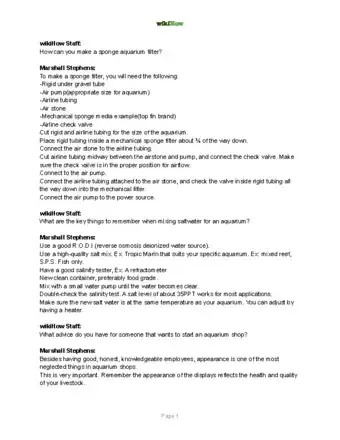
Thanks for reading our article! If you'd like to learn more about aquariums, check out our in-depth interview with Marshall Stephens.
References
- ↑ https://aquariuminfo.org/ghostshrimp.html
- ↑ https://aquariuminfo.org/beginner.html
- ↑ https://aquariuminfo.org/shrimptank.html
- ↑ https://aquariuminfo.org/ghostshrimp.html
- ↑ https://aquariuminfo.org/cycling.html
- ↑ https://aquariuminfo.org/shrimptank.html
- ↑ https://aquariuminfo.org/ghostshrimp.html
- ↑ https://aquariuminfo.org/ghostshrimp.html
- ↑ https://petcentral.chewy.com/keeping-and-breeding-dwarf-freshwater-shrimp/
- ↑ https://petcentral.chewy.com/keeping-and-breeding-dwarf-freshwater-shrimp/
- ↑ https://aquariuminfo.org/ghostshrimp.html
- ↑ https://petcentral.chewy.com/keeping-and-breeding-dwarf-freshwater-shrimp/
- ↑ https://aquariuminfo.org/ghostshrimp.html
- ↑ https://aquariuminfo.org/ghostshrimp.html
- ↑ https://www.theaquariumguide.com/articles/ghost-shrimp-care
About This Article
To take care of ghost shrimp, feed them a small amount of store-bought shrimp pellets twice a day. Or, you can feed your ghost shrimp small bits of boiled vegetables, like zucchini or spinach. Also, make sure you keep the temperature in their tank around 75 degrees Fahrenheit. If you want to add other aquatic animals to the tank with your ghost shrimp, stick with other shrimp species, snails, or small, docile fish. To learn how to set up a tank for ghost shrimp, keep reading!
